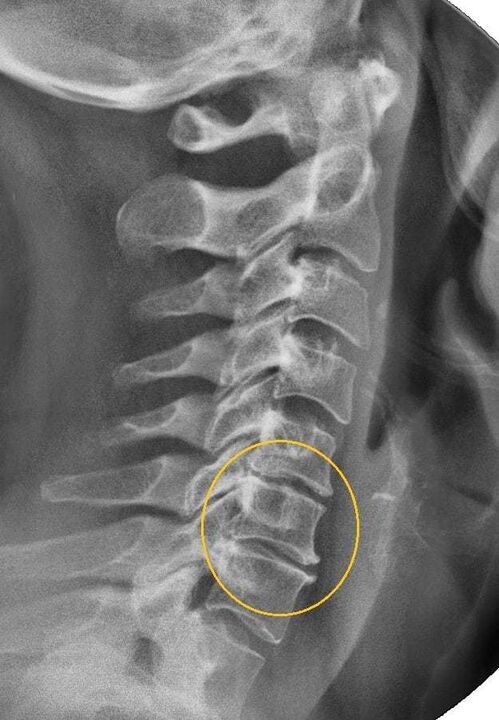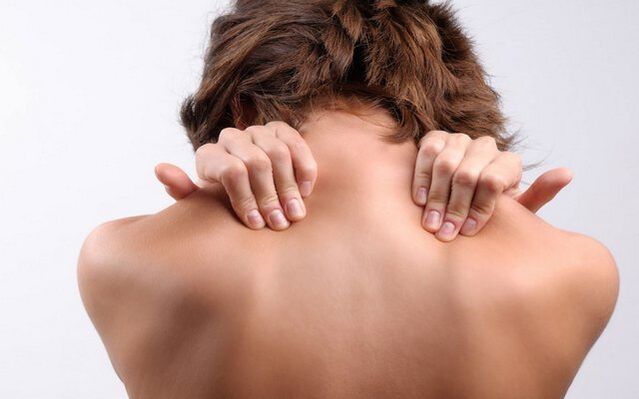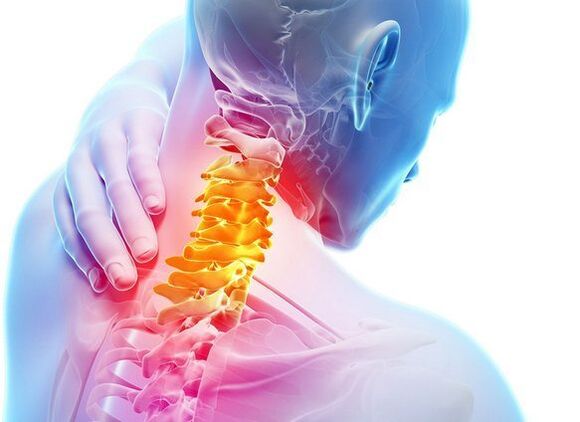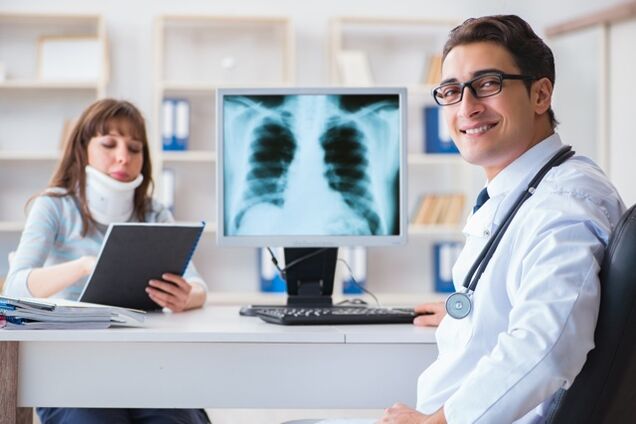Osteochondrosis is a common pathology of the spine, characterized by a dystrophic change in the structure of vertebra cartilaginous discs and their bone base.

In one degree or another, osteochondrosis manifests itself in most people after 30 years. The symptoms of cervical osteochondrosis are diverse, which usually complicates diagnosis and subsequent treatment.
The causes of cervical osteochondrosis
Partially in the development of "guilty" neck osteochondrosis, the disturbance of the modern person and the corresponding distribution of loads along the spine spine, as well as the natural processes of body aging aging, and there are several causing the development and progression of this pathology:
- sedentary lifestyle;
- long stay in the same position during work;
- overweight body weight;
- continuous lesions of the spine in the neck;
- chronic stress, constant nerve tension;
- regular hypothermia of the collar zone muscles (for example, when it is near the air conditioning air flow);
- Congenital vertebral anomalies and intervertebral discs.
General symptoms and signs of cervical osteochondrosis
The osteochondrated process affects any of the spine or several at once. Lombar and cervical vertebrae are more affected by pathologies, such as the most susceptible to cargo due to the anatomy of the human skeleton.
The consequences of spinal osteochondrosis in the cervical region cause the greatest inconvenience and possible complications, because the neck is an area rich in neuromusive highways, many of which directly feed the brain.
For this reason, clinical symptoms with cervical osteochondrosis are many associated with the ischemia of brain areas. In addition, nerve roots, which provide sensitivity and motor activity of the hand and waist of shoulder, when squeezing with destroyed vertebrates can give a variety of symptomatic scenes.

Signs of neck osteochondrosis depend on which body systems are affected by the pathology:
- The interrupted blood circulation due to the compression of the vertebral arteries determines most brain symptom complexes.
- The compression of the roots that leave the vertebrates gives an image of the peripheral nerves injury.
- The pinch of spinal cord areas is associated with serious neurological pathologies found in advanced cases.
Below, consider the general clinic of cervical spine osteochondrosis.
Pain in the back of the head, neck and collar area
This is the most common symptom. The location of the pain can be expanded, affecting the shoulders, the region of the collarbone, chest, turning into intense migraines of the head.
The nature of pain depends on the location of the injury and the severity of the pathology. At first, pain can be rapidly transient, gradually becoming chronic, painful.
In times of exacerbations, the pain becomes throwing, with an increased tone of the neck muscles and limited movement of the head.
Often, pain with cervical osteochondrosis can be located behind the sternum; In this case, many patients take this symptom for angina pectoris. Differentiation can be performed by taking a nitroglycerin pill - pain due to osteochondrosis, they are not removed.
Noise, touch, feeling of congestion on the ears
These symptoms usually join a decrease in hearing. These phenomena are associated with a decrease in blood flow of vertebral arteries to the vestibular apparatus.
The complex of these symptoms is called cochlear syndrome or snail, and is always far from determining its connection with osteochondrosis in the cervical region.
A specific feature for differentiation is that noise, congestion and the touch of the ears are felt when changing the position after a long stay in one position.
Dizziness
The dizziness is also due to a violation of blood flow to the inner ear organs, which ensures body balance. Nystagmus usually joins with dizziness - arbitrary fluctuations on the ocular pupils to the sides.

Shortness of breathe
This sensation appears due to irritation of the ends of the diaphragmatic nerve. It is a component of the cervical nervous beam and is involved in the regulation of breathing, its depth and frequency. Patients complain about the inability to breathe in the full chest.
In some cases, the symptom aggravates the serious misconduct of breathing and asphyxiation. For the same reason, breathing for at night and snoring.
The disadvantage of oxygen due to breathing problems is ultimately the cause of increased fatigue, a decrease in concentration and memory problems.
Nausea
It is accompanied by shots of air. Also due to problems with blood circulation in some areas of the brain and the inner ear. Sometimes nausea is observed with indomitable vomiting caused by head and body movements. The consequence of frequent nausea and vomiting is a decrease in appetite, weight loss, food insufficiency.
Vision Problems
"Flies" in the eyes, a decrease in visual acuity, fog in front of the eyes - these are all symptoms due to the ischemia of the brain area that is responsible for vision.
Patients with osteochondrosis complain less of vision, since the lack of blood supply of vertebral vessels is compensated by the blood flow of the carbon artery system.
Glasses and therapeutic gymnastics for eye muscles do not solve the problem, usually vision improves after treatment of osteochondrosis.
Blood Pressure Council
An unstable level of pressure is due to the impaired blood flow in the oblong brain responsible for the functions of the center of vascular engines.
Sudden fainting, or synchopal states
It occurs with spasm of the brain arteries due to the short -term stop of blood flow along the vertebral arteries.
From the patient's loss of the patient's consciousness, you can be quickly removed, placing it so that the legs are a little higher than the head - the blood flow to the brain allows a person to lead to life.
After a passed out attack, reversible speech problems and movements, due to a brief stop of blood flow, can be observed for some time.

Green symptoms
It can often be the only signal that indicates cervical osteochondrosis. They are expressed as a perspiration, dryness and a throat node sensation, difficulties with swallowing. Symptoms are associated with nervous plexus compression responsible for pharyngeal innervation. It is necessary to differentiate such manifestations from a similar clinic for inflammation or neoplasms.
Raising body temperature
Increased body temperature for cervical osteochondrosis is not the most typical symptom, it is rarely observed locally: in the cervical and collar area, with a slight redness of the skin.
The clinic of osteochondrosis in the cervical spine may be, firstly, varied degrees of gravity, depends on the stage of development of the pathology, also during periods of exacerbations, they are brighter and, second, to form in certain syndromes.
Symptoms, depending on the stage of cervical osteochondrosis
Stage I
The beginning of degenerative processes in the cartilage of vertebral discs. Symptoms are weak, sometimes it may not be observed. The first signs of cervical spine osteochondrosis:
- discomfort in the neck, arms, shoulders, sometimes turning into pain;
- headache;
- Easy restriction of motor activity of the neck;
- Passing rapidly by visual impairment;
- Reducing the sensitivity of the skin of the collar area.
IMPORTANT: These symptoms become more pronounced by tilting their heads.
As a rule, in the first stage of cervical osteochondrosis, patients do not go to the doctor, believing that all symptoms are associated with fatigue, stress, age, lack of sleep.
Stage II
At this stage, the protrusion of vertebrates began, the intervertebral cracks narrow, the fibrous ring fiber of the album is destroyed. There are perceptible painful symptoms of a point of point due to compression of nerve trunks, intensifying during neck movements and head curves. Here you can already suspect cervical osteochondrosis, whose symptoms in the second stage are as follows:
- Pain pronounced in the neck, sometimes with a crisis;
- The skin of the shoulders and hands loses its sensitivity almost completely;
- Headaches are frequent, they do not go through a long time;
- visual impairment with "flies" in the eyes;
- touch and noise in the ears;
- weakness of the upper extremity muscles;
- The clarity of tendon reflexes is reduced;
- Ticket pain with dedication under the shoulder blade;
- The feeling of a knot in the throat, problems with swallowing;
- Sleep disorders, usually insomnia.
Long holding the head in a position leads to intense pain. In this phase of disease development, patients are already arriving at the doctor for help.
Stage III

The fibrous ring on the disc is destroyed, hernias are formed. In the third stage, there is a deformation of the spine, displacement and dislocation of the vertebrae due to its weak fixed. The symptoms are as follows:
- Intensive and acute pain in the neck, collar zone, heart area;
- The sensitivity of the scalp on the back of the head, in the shoulder region, in the hands, to the complete absence of;
- Cervical spine hernia;
- Paresis and paralysis of the upper ends;
- The tendular reflexes are virtually not observed.
This is a severe stage of the disease where the patient is no longer able to support his head on his own. The ischemia of the spinal cord and the compression of the arteries of the spine lead to paralysis and paresis in other parts of the body and in the spine.
Syndromes caused by cervical spine osteochondrosis
Non -specific and a large number of various symptoms that accompany cervical spine osteochondrosis make it difficult to diagnose and additional treatment, as some of them may be a sign of completely different diseases. Symptoms of cervical osteochondrosis are formed in certain groups called syndromes. Its presence and severity may indicate a pathology in the cervical spine with an updated location.
A group of often found syndromes:
KORESHKA. Otherwise, called cervical radiculitis. It combines the symptoms associated with violation of nerve roots of cervical vertebrae. The "goose bumps" in the affected area, tingling the fingers, forearms, skin pasture, scattered to certain fingers are characteristic.
Irritive reflection. The burning and acute pain on the back of the head and neck, sometimes with the return on the chest and shoulder, which occurs at the time of head position change and neck when sneezing, cough and a sharp curve of the head.
Vertebral Artery Syndrome includes:
- headache, attacks or constantly pulsating in nature;
- discomfort in some movements, including after a long static position;
- weakness, nausea, loss of consciousness;
- Limit reduction, problems with balance;
- Reducing visual acuity.
Cardiac. Almost the same image with angina pectoris usually leads to inadequate diagnosis and treatment. The syndrome appears due to irritation of diaphragmatic nerve receptors, partially captivating the pericardium and a large thoracic muscle. Thus, cramps in the heart region are more reflected, such as a revision of cervical nerve irritation. Symptoms:
- Suddenly, starting, prolonged pain, intensifying with a clear movement of the neck, cough, sneezing, without passing by taking heart drugs.
- ECG does not show an impaired blood flow of the heart muscle.
- Sometimes there may be extrastole and tachycardia.
Vegetative-diabolic syndrome. Subluxa The first vertebra of cervical starting with a displacement can lead to the development of vegetation-vascular dystonia. It is not a certain diagnosis of VVD, as it has no pronounced symptoms.
There may be neurological signs, symptoms of impaired cerebral blood flow, intracranial pressure, muscle cramps.
As a result, the patient's complaints boil down to dizziness, a decrease in visual acuity, loss of consciousness, headaches, nausea.
How to treat cervical osteochondrosis
The described state of the spine is a very serious pathology, which, negligently, leads to disability and as a result of deep disturbances of brain circulation - and death. For this reason, by self -medication, if these symptoms appear, you should not do.
Osteochondrosis is treated in a hospital and at home exclusively as a prescription.
In the early stages, the treatment of cervical osteochondrosis is conservative, including medicines prescriptions: non -steroid anti -inflammatory drugs, anesthetics, hormonal drugs, vitamin complexes, all -relieved chondoprotectors, pain, improve soft tissue trophies and ridicules.

In the acute period, the medications are prescribed in the form of injections as the pain disappears, the patient goes to the tablets. Physiotherapy, massage, exercise exercises, usually prescribed in the remission phase, join drug courses. In difficult cases, osteochondrosis is treated with surgery.
Prevention
The base of the health of the cervical spine is a strong and healthy back, physical activity, a comfortable bed with pillows and anatomical mattresses, proper posture and proper nutrition.
It is worth avoiding neck injuries and weight lifting. It is necessary to combine prolonged sitting with rest and hot periods.
Recovery forecast
The prognosis for qualified and timely treatment is favorable, but it depends greatly on the patient's age, the severity of the manifestations and the stage of the disease. It is also important in which the person performs medical recommendations on nutrition, lifestyle and eliminates bad habits.
Conclusion
Thus, in most cases, cervical osteochondrosis can be cured. However, it is worth remembering that the disease may return at any time. To avoid this, it is necessary to observe prevention measures and a healthy lifestyle.
Also, it is worth remembering:
- The cause of osteochondrosis is difficult to establish.
- The symptom of the disease is pain in the back of the head and neck.
- Cervical osteochondrosis is treated comprehensively: medicines (especially NSAIDs), massages, exercise therapy.























